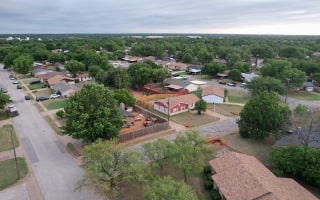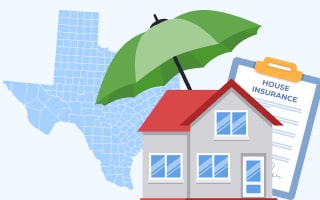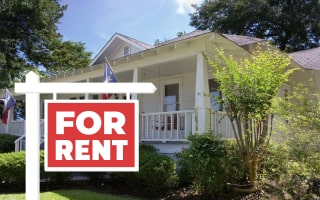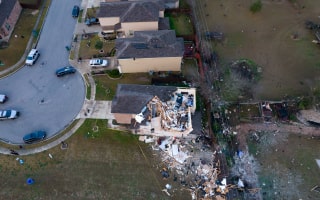Homeowners Insurance in Texas

Texas is home to the Alamo, great barbecue, and oil rigs. However, it's also a place riddled with extreme weather events. Disasters can strike anytime, especially in states with violent weather, such as Texas. Homeowners insurance protects your home against acts of God and other perils. Located in the Southeast, Texas is prone to violent tornadoes, landslides, floods, earthquakes, and hurricanes. Since 1953, Texas has had 255 federally declared disasters, more than any other state except for California. The rate of disasters per 1 million people is 8.23.
Along with abundant claims for property damage through natural disasters, Texas residents also file claims for water damage due to flooding, burst pipes and faulty plumbing, fire and smoke damage, theft, and vandalism.
Texas does not legally require homeowners to carry insurance on their property, but mortgage companies do. The lender will require you to purchase homeowners insurance whenever you take out a mortgage. That way, if anything happens to the home, it will be repaired or replaced, and the lender won't lose money. You can choose your insurance provider, but you must provide proof of coverage before closing. There are no state or local regulations regarding homeowners insurance in Texas. It is entirely up to you if you want to purchase more or less coverage.
As of October 2024, the national average for homeowners insurance is $2,728 a year or $227 a month. Texas homeowners pay an average of $4,400, which is grossly more than the national average due to frequent weather disasters.
Types of Homeowner Insurance Coverage Available in Texas
Every state and insurance provider offers different kinds of coverage depending on the weather conditions and risk potential of other perils. Texas has a lot of risk; therefore, only certain providers operate within the state. The types of homeowners insurance available in Texas are:
-
Dwelling: This type pays for repairing or replacing your home if it is damaged or destroyed.
-
Personal Property: Covers your furniture, clothing, and other personal belongings if damaged, stolen, or destroyed.
-
Other Structures: This insurance covers buildings not attached to your home, such as sheds, garages, and barns.
-
Additional Living Expenses: If your home is uninhabitable and you must move out while it is fixed, this insurance will pay for any extra expenses.
-
Personal Liability: If you unintentionally injure someone, this pays their medical bills, lost wages, and court fees if they sue you.
-
Medical Payments: Medical payments cover the medical bills for anyone hurt while on your property. For example, if someone slips and falls on your icy steps or your dog bites them.
Consider purchasing an umbrella policy that covers anything the other coverages do not. This policy provides a safety net to ensure you can restore your property to its original state.
Generally, insurance carriers do not provide insurance for flooding, earthquakes, or tornados. You can sometimes purchase special insurance to cover them, but only rare providers offer it. Even though hurricanes are rare, it is good to have them when your house is damaged due to rain, high winds, and other natural disasters.
FEMA (Federal Emergency Management Agency) manages the National Flood Insurance Program (NFIP) through a network of 50 providers across the U.S. Since most homeowners insurance does not cover floods, this supplemental coverage can repair damage and replace items after a flood. Depending on your options, it can cover the building and/or your personal belongings. This program is available to homeowners, renters, and businesses. Learn more about the program on FEMA's website.
Home Insurance and Natural Disasters
Many natural disasters are covered under homeowners insurance, but some are not. You can expect coverage for windstorms, hail, explosions, fire, and sudden water damage. But most companies will not pay for floods, earthquakes, and wind damage to your trees or shrubs. Texas is fraught with terrible weather, and due to climate change, it is getting worse every year. Severe weather is the main reason for home insurance rate increases. In just the last five years, rates have spiked 34% across the U.S. and even as high as 60% in some areas. In Texas, rates have increased by 59.9%.
Texas is prone to terrible weather, such as tornadoes, landslides, floods, earthquakes, and hurricanes. Just one fire or lightning claim costs insurers an average of $77,340. Water and freezing claims average $11,650, and hail and wind damage cost an average of $11,695. Texas ranks number #3 on the list of highest losses from 2015 to 2019, totaling $5,865,190,400. In 2022, Texas had 4,490 lightning insurance claims totaling $95,200,000. Seven percent of homes are at risk of wildfire damage (717,800 homes). Texas also ranks high on the list of properties at risk of hurricane damage. From 2017 to 2019, Texas had the highest number (637,977) of hail damage claims in the U.S. Texas also had 1,003 dog bite claims, averaging $39,884. From 1980 to 2024, Texas had 179 billion-dollar disasters.
How Can I Save on Homeowner Insurance Premiums in Texas?
Many things affect your homeowners insurance rates. As they continue to climb, homeowners need to find ways to save. The things that affect your rates that you may be able to adjust are:
-
Location: Your location matters the most. If you live in an area with frequent natural disasters, your likelihood of filing claims is higher, and your rates will be as well. The same is true if you live in a city where crime is higher.
-
On-site Risks: The more risks you have on your property (pools, hot tubs, treehouses, etc.), the higher your rates will be.
-
Your Deductible: The higher your deductible, the lower your rates will be. Conversely, the lower the deductible, the higher your rates.
-
Your Credit Score: People with a high credit score pay much lower premiums than those with poor credit.
-
Condition of Your Home: Houses in good condition will earn lower rates than those in disrepair.
-
Size & Age of Your Home: The size of the house matters; the more significant the home, the more it will cost to rebuild after a qualifying event. Newer homes cost far less to insure than older homes.
-
Previous Claims: If you have a history of filing claims, you will pay more than someone who doesn't file claims.
-
Coverages: The more coverage you purchase, the higher your rates.
-
Financed vs. Owned: When you finance your home, your lender dictates your coverage levels. If you own it outright, you get to decide.
-
Construction Materials: Homes built with code-friendly materials like fire-retardant shingles and siding will pay less for insurance premiums.
-
Pets: Some types of pets are dangerous and will mean you pay more for your insurance rates.
Some ways to save on homeowners insurance in Texas include:
- Ask for Recommendations/Shop Around: Ask for provider recommendations and shop around. Get multiple quotes before deciding.
- Raise Your Deductible: Raise your deductible as high as possible to save on home insurance.
- Make Your Home Safer: Install home security and replace your roof, windows, or siding to strengthen your home and pay lower insurance.
- Fire Safety Upgrades: Install smoke alarms, fire extinguishers, and sprinklers to get a break on your home insurance rates.
- Don't File Small Claims: Don't file small claims. Wait until you need the insurance to use it.
- Bundle Policies: Bundle multiple policies together, and your insurer should cut you a better deal.
- Ask for Discounts: Ask your insurance agent for any discounts that might apply to you.
- Improve Your Credit: Ask your agent to re-evaluate and lower your rates accordingly.
- Avoid High Risks: Don't add new risks to the property and eliminate existing ones.
Home Insurance Discounts in Texas
If your home is damaged or destroyed, homeowners insurance pays to repair or replace it. However, this type of insurance is not cut and dry. It's essential to know all you can about Texas home insurance to protect your home as well as possible. Most policies include dwelling coverage, liability, personal property, other structures, medical payments, and ALE coverage.
You can get a policy easily by finding a provider and then contacting them by phone or online through their website. You can also find a local agent to help you decide on coverage limits and set you up. You must pay the first year in advance, and then after that, you can pay through your mortgage escrow or once a year.
Most providers offer the following standard discounts:
- Senior Discount: Most providers offer seniors a discount on their home insurance.
- Military Discount: Military members are eligible for homeowners insurance discounts.
- Veteran Discount: Vets also get discounted rates on home insurance.
- Claims-Free Discount: Stay claims-free for as long as possible, and you should pay less than someone with claims.
- Early Quote Discount: Get quotes in advance and earn a discount on your insurance.
- Fire-Safety Discount: Install fire safety features like sprinklers, fire extinguishers, and smoke alarms to earn a discount on your home insurance.
- Security/Smart-Home Discount: Install a security system or smart home devices that monitor for issues and earn a discount on your insurance.
- New Home Discount: New construction homes earn discounts of up to 40% off.
- Non-smoker Discount: Non-smokers pay less on home insurance than smokers due to reduced fire risk.
- Location-based Discount: Some locations earn discounts for being low-risk and safer.
- Bundling Discount: Bundle multiple policies together with the same carrier for a discount.
- Loyalty Discount: When you stay with the same company for many years, they often discount your rates as a thank you.
- Paperless Discount: Sign up for paperless statements and receive a home insurance discount.
- Auto-Pay Discount: Most providers offer a small discount for auto payments.
Common Rates Offered by Homeowners Insurance Firms
New homes cost a lot less to insure than older homes. In many cases, it costs up to 40% less, and homes five years old or younger can cost up to 26% less. Texas new construction homeowners pay an average of $2,919, which is much less than you pay if your home is older. Your actual price will vary based on many factors, including the insurance company, your age, credit score, claims history, etc.
Top 10 Home Insurance Firms in Texas and Average New Home Savings
| Company | % savings |
|---|---|
| Nationwide | 76% |
| State Farm | 51% |
| Chubb | N/A |
| Travelers | 63% |
| Amica Mutual Insurance | N/A |
| USAA | 54% |
| Allstate | 47% |
| Farmers Insurance | N/A |
| Texas Farm Bureau Mutual | N/A |
| Liberty Mutual | N/A |
Home Insurance and Renovations in Texas

Home upgrades can rejuvenate your living area and add quality and value to your home, but they can also impact your home insurance rates. Some renovations add risk and increase your rates. Others may reduce risk and decrease your rates, while others may have no effect at all.
![]() Home Renovations that Increase Rates
Home Renovations that Increase Rates
Some home renovations that increase your rates include:
- Adding a Room: Adding more room to make everyone feel comfortable is great, but it adds more space and value and will cost more to insure.
- Remodeling: Upgrading your outdated flooring, carpets, appliances, and light fixtures can add beauty and value to your home, but it will also increase the cost of your home insurance. The more luxury, the higher the cost.
- New Fireplace: Nothing beats a fire on a cold winter's night, but adding a fireplace to your home will drastically increase your fire risk and your home insurance premiums.
![]() Home Renovations that Decrease Rates
Home Renovations that Decrease Rates
Some home renovations that decrease your rates include:
- Storm-Resistant Roof: Installing a new storm-resistant roof that better withstands storms can help lower your insurance costs.
- Hurricane Straps/Ties: Fortifying your home with hurricane straps and ties could help avoid claims and keep your home safe. These reinforcements could also help you save on insurance.
- Upgrade to Storm Windows: Storm or shatterproof windows are a good idea, especially in Minnesota, where tornadoes and windstorms are prevalent. They can also help you save money on your home insurance.
A new roof is a good investment in strengthening your home against perils. However, if you use expensive or luxury materials like metal, your rates may increase, canceling out any savings.
When you upgrade your home, your insurance does not cover the cost. It only pays to replace or repair your home after a disaster. Other things not covered are expensive items like jewelry, furs, cars, collectibles, mold, fungus, animal damage, pest infestations, and rodents.
Discussing a potential renovation with your local agent before breaking ground is crucial. Find out how it will impact your coverage, how much more you might need after, and how it will affect your rates.
Texas Renters' Insurance

Texas renters also need homeowners insurance protection. However, these policies are a bit different. They do not include any dwelling coverage for the structure of the home. That must be covered by the property owner on their policy. Renters insurance does cover personal property and pays to replace your belongings if they are destroyed in a fire, windstorm, theft, or vandalism. Most policies also include liability, medical payments, and loss of use coverage. Anything outside of the policy limits will not be covered.
Some covered perils include:
-
Smoke
-
Fire
-
Windstorms
-
Hail
-
Theft
-
Vandalism
Some of the items that renters insurance covers are:
-
Small Appliances
-
Furniture
-
Clothing
-
Bedding
-
Bath Items
-
Electronics
-
Sporting Equipment
Renters insurance is priced according to three main factors, and they are:
-
Location: Even as a renter, your location matters. If you live in the city, you will pay more than if you live in the country. If your area has many weather events, you will pay higher rates.
-
Coverage Amount: The more coverage you buy, the higher your premiums.
-
Number of Units: The more units in your building, the lower your rates.
The average renter in Texas pays between $11.83 and $25 a month. The national average for renters insurance is between $15 and $20 monthly. People in cities with higher crime rates will pay more than those in the suburbs.
Condo Insurance in Texas

Condo owners also need home insurance, but condo insurance, or HO-6, differs slightly from homeowners. Condo associations have their own master policy that protects the dwelling and will pay to replace each building after a disaster and restore it to its original condition (when first built). That may not include any updates made by owners. That is where HO-6 insurance comes in to restore the interior to its most recent condition, complete with any updated appliances, flooring, kitchens, baths, etc. Condo insurance also includes liability, medical payments, personal property, loss of use, and loss assessment coverage.
Unlike renters insurance, condo insurance has some dwelling coverage but is limited to only the interior. Also, the liability portion only applies to someone who gets hurt inside the condo, not outside on common grounds.
After a qualifying event, condo insurance pays to replace the following items:
- Appliances
- Flooring
- Interior Walls
- Wiring
- Plumbing
- Light Fixtures
- Cabinets
- Countertops
- Personal Belongings
Texas condo owners pay an average of $730 a year or $61 a month, which is considerably higher than the national average of $625 for $60,000 of personal property protection, $300,000 of liability, and a $1,000 deductible.
Some ways you can save on condo insurance include:
- Raise Your Deductible
- Review and Adjust Your Policy Every Year
- Improve Your Credit
- Stay Claims Free
- Shop Around for the Best Rates
- Bundle Policies
- Improve Home Security
- Install Fire Safety Devices
- Ask for Discounts
- Remain Loyal to the Same Provider
Texas Home Insurance Market
The Texas home insurance market is highly competitive, with most major brands battling for consumers. It can be challenging to find the best homeowners insurance without help. Talk to your local agent; they can assess your property and give you a quote while offering discounts and other incentives. In 2023, Texas had more severe storms than any other state, and Texas insurance providers lost more money than anywhere else in the U.S.
Texas insurance carriers are in trouble with more severe weather events like tornadoes, landslides, floods, earthquakes, and hurricanes. As this trend continues and claims rise and losses mount, providers may pull out of the state, leaving consumers with few options.
No federal agency regulates the insurance industry. Instead, states appoint a department or agency to monitor providers and rates, evaluate and investigate customer complaints, and sanction guilty firms. In Texas, this agency is the Department of Insurance, located at 333 Guadalupe Street, Austin, TX 78701.
Homeowners Insurance Guide
- Homeowners Insurance in Texas
- Types of Homeowner Insurance Coverage Available in Texas
- Home Insurance and Natural Disasters
- How Can I Save on Homeowner Insurance Premiums in Texas?
- Home Insurance Discounts in Texas
- Home Insurance and Renovations in Texas
- Texas Renters' Insurance
- Condo Insurance in Texas
- Texas Home Insurance Market
Instant Access to Texas Property Records
- Owner(s)
- Deed Records
- Loans & Liens
- Values
- Taxes
- Building Permits
- Purchase History
- Property Details
- And More!
Homeowners Insurance Guide
- Homeowners Insurance in Texas
- Types of Homeowner Insurance Coverage Available in Texas
- Home Insurance and Natural Disasters
- How Can I Save on Homeowner Insurance Premiums in Texas?
- Home Insurance Discounts in Texas
- Home Insurance and Renovations in Texas
- Texas Renters' Insurance
- Condo Insurance in Texas
- Texas Home Insurance Market